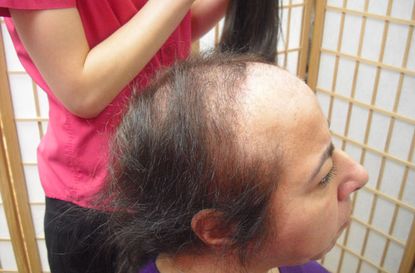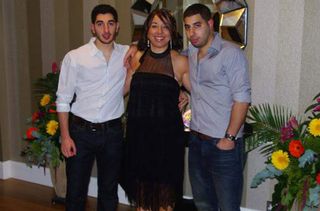'My sons used to ask: Mummy why don't you have any hair?' Brave mum opens up about battle with trichotillomania
Angela Habeshis suffers from a mental health condition that causes her to pull out her own hair


An inspirational mum of two has opened up about a mental health condition that caused her to pull her own hair out since she was 10 years old - leaving her with large bald patches for most of her life.
Angela Habeshis, 51, suffers from trichotillomania (TTM). For years, Angela, who lives in Hertfordshire, kept her condition secret from her husband Demos and their two grown up sons.
'I started pulling out my own hair at the age of 11,' says Angela. 'Thinking back, I put it down to changing schools, my hormones and bullying.'

Angela with her two sons
At first, the damage she was doing to her hair was easy to disguise.
'I had curly hair and I used to wear my hair up and managed to keep my bald patches hidden. The thing with trichotillomania is that you keep it a secret. It's always done in private and you hide it well from your family and friends.'
Angela admits she never spoke about her condition to anyone and if it was ever brought up in conversation, she would quickly change the subject.
GoodtoKnow Newsletter
Parenting advice, hot topics, best buys and family finance tips delivered straight to your inbox.
'The only time my sons had ever commented was when they were little and started noticing that other mothers at the school gates had nice hair,' Angela says.
'They'd ask, "Why don't you have hair, Mummy?" But as they grew up, they never mentioned it. It's hard to talk about it because you feel so guilty: you're doing this unsightly thing to yourself.'
Angela says she managed to keep the condition a secret from her husband for a long time and even managed to pass it off as a side effect of pregnancy.
'I was 21 when I met Demos. Arranged marriages aren't as usual in the Greek Cypriot community as they once were, but they do exist,' Angela says, 'My husband and I started to get to know each other properly after our wedding, but I managed to keep my hair problems from him – I think he thought my hair loss was down to pregnancy hormones.'
For a while, Angela helped Demos with his business, but socialising left her feeling uncomfortable and she hated meeting anyone new as she constantly worried about her hair.
'As your hair gets thinner, people make comments and it just perpetuates the TTM cycle.'
In her thirties, Angela became extremely depressed, put on weight and became to withdraw from family life.
'I was pulling my hair more and more – it was the stress of being a parent; the stress of having TTM and the effect it was having on my appearance and my self-esteem. The self-destructiveness and loneliness of it all just overwhelmed me.'
Angela says she even pulled her hair out at night, hoping to hide her actions from her husband: 'I often pulled my hair out late at night and I'd get up in the morning and quickly clear away all the hair on the floor, so Demos wouldn't notice.'

Angela with her hair replacement prosthesis feeling a new lease of life
Amazingly, it wasn't until Angela read an article about trichotillomania in a magazine that she realised she wasn't alone and that it was in fact a recognised mental health condition.
'It spurred me on to tell my husband for the first time and he and our sons were incredibly accepting. As soon as I realised my hair problem was an actual medical condition, I turned straight to my computer and started Googling.'
Her search session resulted in Angela finding out about a conference on TTM in Texas. She told her husband she just had to go and booked her flights. The experience was overwhelming and even triggered panic attacks: 'I was shaking in the hotel and, in lectures, listening to other people's stories, I just cried and cried – it all poured out of me.'
When she got home, Angela contacted Lucinda Ellery, a hair-loss consultant who offers something called the Intralace system – a pioneering hair replacement prosthesis constructed from a breathable mesh and integrated into your existing hair. It gave Angela the confidence boost she needed after years of hiding herself away.
'When I got home from my appointment wearing it, everyone was shocked – they couldn't believe it was me,' Angela admits, 'It took me at least a year to get used to wearing the Intralace and I struggled with the idea of knowing I'll wear it for the rest of my life.'
Sadly, Angela has done so much damage to her hair that if any grows back, it is sparse and white. But she says that with her Intralace system on, she feels more herself.
'I just bless the fateful day that I picked up that magazine and found out I wasn’t alone. From that point, I felt that there was hope for me to start living a normal life without hiding away.'
For more information about Lucinda Ellery, visit lucindaellery-hairloss.co.uk
Trusted, informative, and empathetic – GoodToKnow is the ultimate online destination for mums. Established in 2007, our 15-year-strong archive of content includes more than 18,000 articles, 1,500 how-to videos, and 7,000 recipes.
-
 Compromising may be killing your relationship - here are 5 ways to reach healthy compromises, according to relationship expert
Compromising may be killing your relationship - here are 5 ways to reach healthy compromises, according to relationship expertCompromising isn't always the best way to keep the peace in a relationship
By Charlie Elizabeth Culverhouse Published
-
 Best interactive pets for kids: 15 gift ideas for children of all ages
Best interactive pets for kids: 15 gift ideas for children of all agesFrom puppies to axolotls, take a look at our selection of the best interactive pets you can buy that are sure to be a hit with little animal lovers
By Sarah Handley Published